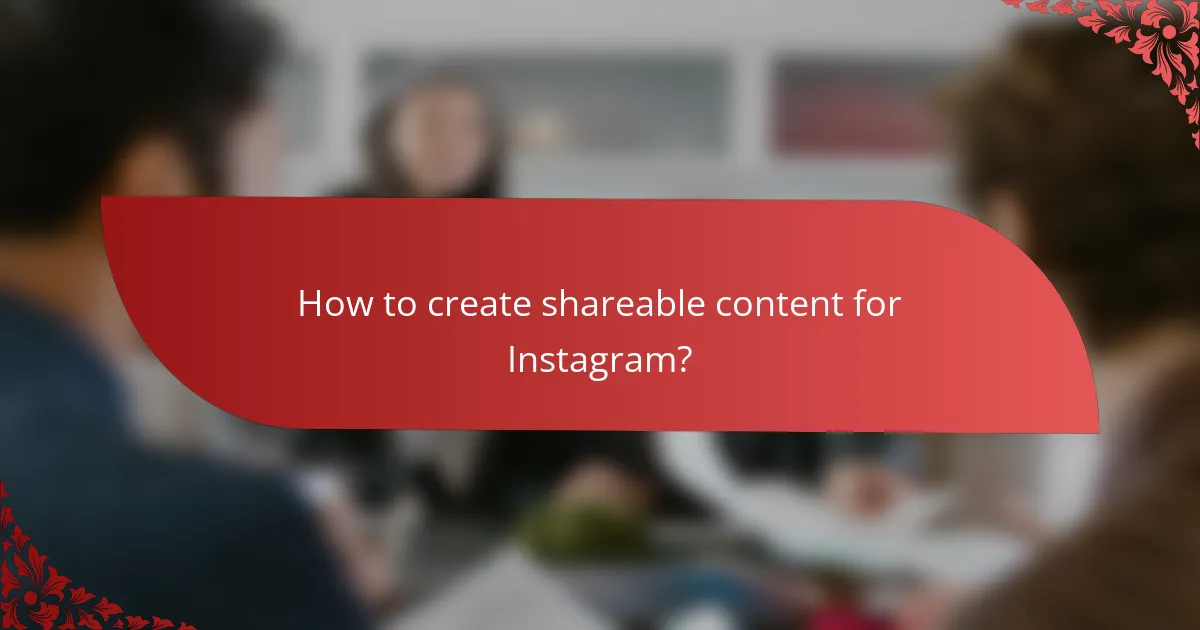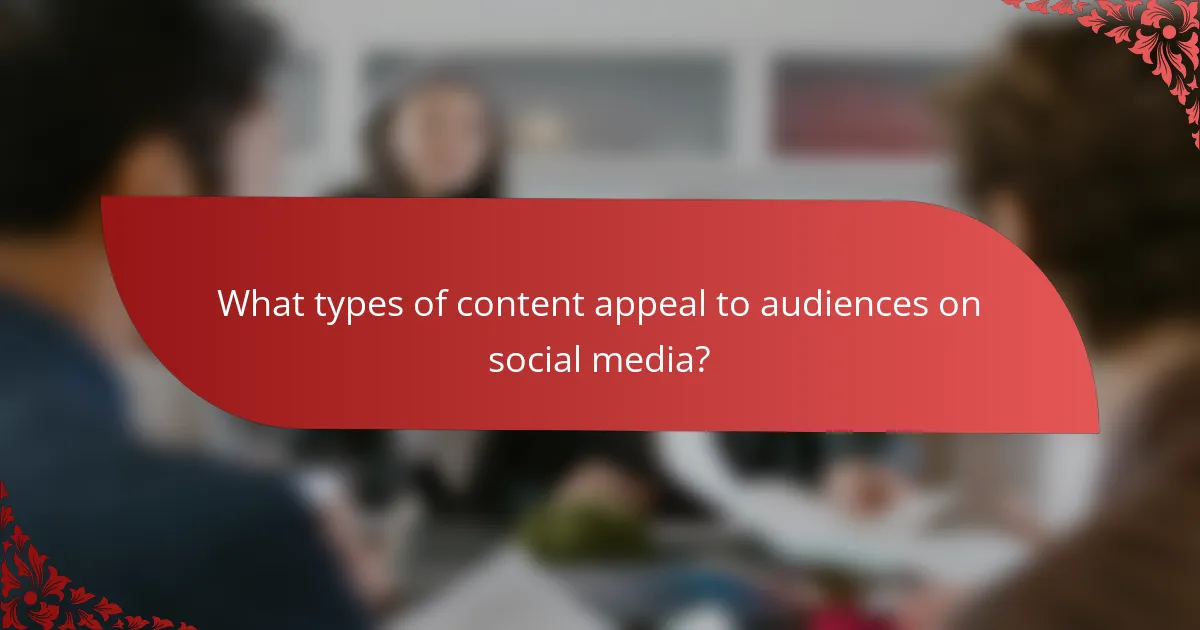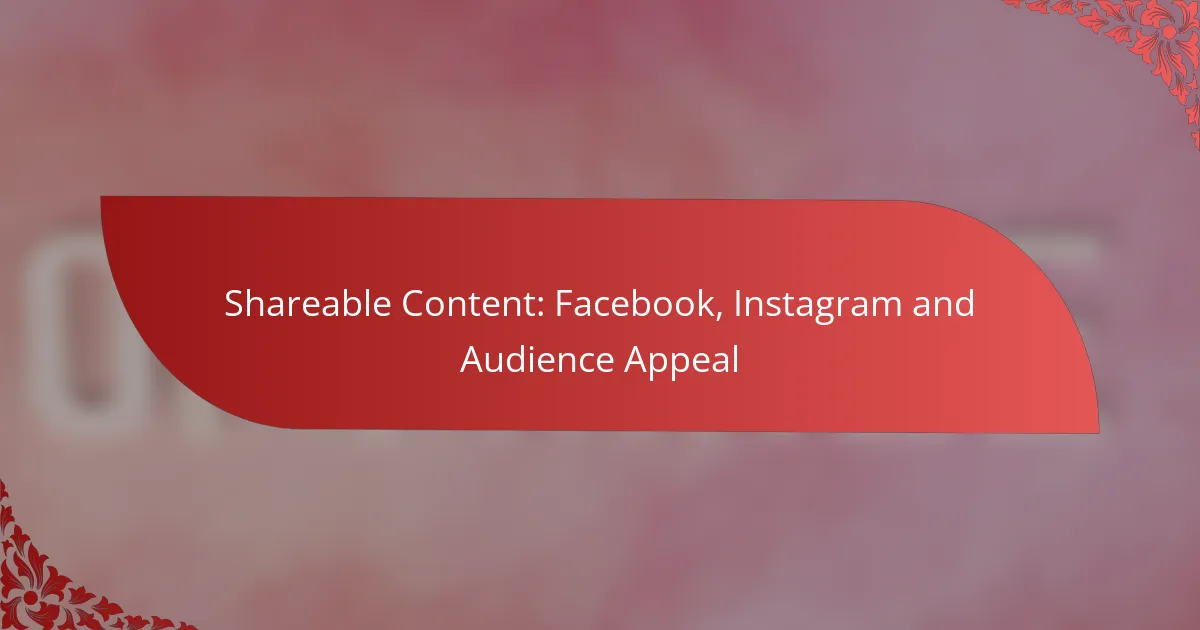Creating shareable content on platforms like Facebook and Instagram requires a strategic approach that emphasizes visual appeal and audience connection. By utilizing high-quality visuals, engaging headlines, and interactive elements, you can enhance the likelihood of your posts being shared. Additionally, incorporating authentic user contributions and insights into your brand fosters a sense of community, further increasing audience engagement.

How to create shareable content for Facebook?
Creating shareable content for Facebook involves producing engaging, visually appealing posts that resonate with your target audience. Focus on high-quality visuals, compelling headlines, and precise audience targeting to maximize shares and interactions.
Engaging visuals
Visual content is crucial for grabbing attention on Facebook. Use high-resolution images, videos, or infographics that are relevant to your message. Bright colors and clear compositions tend to attract more engagement.
Consider using tools like Canva or Adobe Spark to create eye-catching graphics. Aim for a mix of formats, such as short videos or carousel posts, to keep your audience interested and encourage sharing.
Compelling headlines
Your headline is often the first thing users see, making it essential for driving clicks and shares. Use action-oriented language and pose questions to spark curiosity. For example, instead of “Tips for Healthy Eating,” try “Discover 5 Easy Ways to Eat Healthier Today!”
Keep headlines concise and impactful, ideally under 10 words. Incorporating numbers or emotional triggers can increase the likelihood of shares, as people are drawn to clear, actionable content.
Audience targeting
Understanding your audience is key to creating shareable content. Use Facebook Insights to analyze demographics, interests, and behaviors of your followers. Tailor your content to meet the specific preferences of these groups.
Consider segmenting your audience based on their engagement levels or interests. This allows you to create personalized posts that resonate more deeply, increasing the chances of shares and interactions.

How to create shareable content for Instagram?
To create shareable content for Instagram, focus on producing visually appealing posts that resonate with your audience. Engaging imagery, relevant hashtags, and dynamic formats like stories and reels can significantly enhance shareability.
High-quality images
High-quality images are essential for attracting attention on Instagram. Use clear, well-composed photos that reflect your brand’s aesthetic. Aim for a resolution of at least 1080 x 1080 pixels to ensure your images look professional.
Consider using natural lighting and editing tools to enhance your photos. Avoid overly filtered images, as they can detract from authenticity, which is crucial for audience engagement.
Use of hashtags
Effective use of hashtags can expand your content’s reach on Instagram. Research popular and relevant hashtags within your niche, aiming for a mix of high-traffic and niche-specific tags. Using around 5 to 15 hashtags per post is generally effective.
Be cautious not to overuse hashtags, as this can appear spammy. Instead, focus on quality and relevance to connect with your target audience more genuinely.
Stories and reels
Instagram Stories and Reels are powerful tools for creating shareable content. Stories allow for quick, engaging updates that can include polls, questions, and interactive elements, encouraging audience participation.
Reels, on the other hand, are short videos that can showcase creativity and trends. Aim for content that is entertaining or informative, as this increases the likelihood of shares. Keep your Reels under 30 seconds for optimal engagement.

What types of content appeal to audiences on social media?
Content that resonates with audiences on social media includes interactive elements, authentic user contributions, and insights into the brand’s inner workings. These types of content foster engagement and create a sense of community among followers.
Interactive polls
Interactive polls are a great way to engage your audience by inviting them to share their opinions on various topics. They can be easily created on platforms like Facebook and Instagram, allowing users to participate with just a tap or click.
To maximize participation, keep polls simple and relevant to your audience’s interests. For example, ask questions about their preferences or opinions related to your brand, such as favorite products or upcoming trends.
User-generated content
User-generated content (UGC) involves sharing photos, videos, or testimonials created by your audience. This type of content not only showcases your products in real-life scenarios but also builds trust and authenticity.
Encourage your followers to share their experiences with your brand by creating specific hashtags or running contests. Highlighting UGC on your social media pages can significantly boost engagement and foster a sense of community among your audience.
Behind-the-scenes posts
Behind-the-scenes posts provide a glimpse into the inner workings of your brand, helping to humanize your business and create a connection with your audience. Sharing stories about your team, production processes, or day-to-day operations can make your brand more relatable.
Consider using formats like short videos or photo stories to showcase these moments. This transparency can enhance trust and loyalty, as followers appreciate seeing the effort and passion that goes into your products or services.

What are the best practices for optimizing shareability?
To optimize shareability on platforms like Facebook and Instagram, focus on creating engaging, visually appealing content that resonates with your audience. Key practices include timing your posts effectively, promoting across multiple platforms, and incorporating strong calls to action.
Timing of posts
Timing plays a crucial role in maximizing shareability. Posts made during peak engagement hours, typically early evenings and weekends, tend to receive more interactions. Research suggests that weekdays around lunchtime can also yield good results, especially for professional audiences.
Consider using analytics tools to determine when your specific audience is most active. Adjust your posting schedule accordingly to align with these peak times, ensuring your content reaches the largest possible audience.
Cross-platform promotion
Cross-platform promotion enhances shareability by leveraging the strengths of different social media channels. For instance, share a visually striking Instagram post on Facebook to tap into a broader audience. Tailor your message slightly for each platform to maintain relevance and engagement.
Utilize stories, reels, and posts to create a cohesive narrative across platforms. Encourage followers on one platform to check out your content on another, increasing overall visibility and shareability.
Call-to-action strategies
Effective calls to action (CTAs) can significantly boost shareability. Use clear, compelling language that prompts users to share, comment, or engage with your content. Phrases like “Tag a friend who needs to see this!” or “Share your thoughts below!” can drive interaction.
Experiment with different CTA placements and formats, such as including them in captions, images, or videos. Monitor engagement metrics to identify which strategies resonate best with your audience, allowing you to refine your approach over time.

How to measure the effectiveness of shareable content?
Measuring the effectiveness of shareable content involves analyzing various metrics that indicate how well the content resonates with the audience. Key areas to focus on include engagement metrics, share and reach statistics, and conversion tracking, each providing insights into different aspects of content performance.
Engagement metrics
Engagement metrics are crucial for understanding how users interact with your content. Key indicators include likes, comments, shares, and time spent on the post. High engagement rates typically suggest that the content is appealing and relevant to the audience.
To evaluate engagement, track these metrics over time and compare them against industry benchmarks. For example, a post with a 5% engagement rate may be considered strong in many sectors, while lower rates could indicate a need for content improvement.
Share and reach statistics
Share and reach statistics help determine how widely your content is distributed across platforms like Facebook and Instagram. Reach refers to the total number of unique users who see your content, while shares indicate how often it has been passed along by users.
Monitoring these statistics can reveal the viral potential of your content. Aim for a high share-to-reach ratio; if a post reaches 1,000 users and is shared 100 times, that’s a 10% share rate, which is generally favorable. Adjust your strategies based on which types of content garner the most shares.
Conversion tracking
Conversion tracking assesses how effectively your shareable content drives specific actions, such as purchases or sign-ups. This metric is vital for understanding the return on investment (ROI) of your content marketing efforts.
To implement conversion tracking, use tools like Facebook Pixel or Google Analytics to monitor user behavior after they engage with your content. For instance, if a promotional post leads to a 2% conversion rate, you can analyze the content to replicate its success in future campaigns. Always ensure your tracking methods comply with data privacy regulations, such as GDPR in Europe.

What tools can enhance content shareability?
Several tools can significantly improve the shareability of content on platforms like Facebook and Instagram. These tools help streamline design, scheduling, and analytics, making it easier to create engaging posts that resonate with your audience.
Canva for design
Canva is a user-friendly graphic design tool that allows users to create visually appealing content tailored for social media. With a wide range of templates and design elements, it caters to various styles and branding needs.
To enhance shareability, focus on using high-quality images and consistent branding. Utilize Canva’s features like resizing for different platforms and incorporating engaging text overlays to capture attention quickly.
Common pitfalls include overcrowding designs with too much text or using low-resolution images. Aim for simplicity and clarity to ensure your content stands out in crowded feeds.
Buffer for scheduling
Buffer is a scheduling tool that allows users to plan and automate their social media posts across multiple platforms. By scheduling content at optimal times, you can increase visibility and engagement with your audience.
Consider analyzing when your audience is most active to maximize reach. Buffer provides insights into the best times to post, which can help you tailor your content strategy effectively.
Avoid the mistake of posting too frequently or too infrequently. Establish a consistent posting schedule that keeps your audience engaged without overwhelming them, typically aiming for a few posts per week on each platform.
